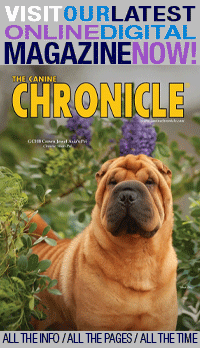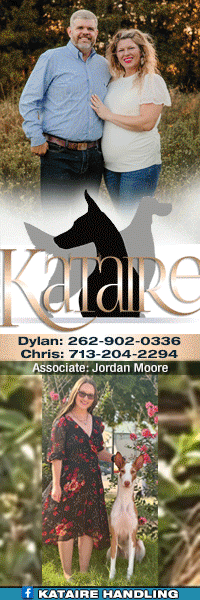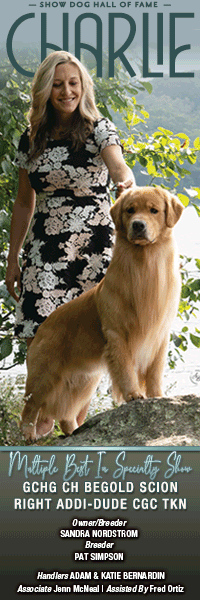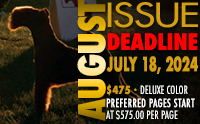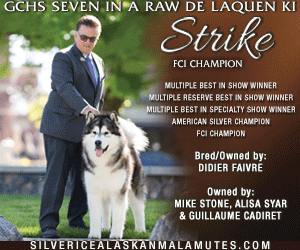The Big Picture
by Lisa Dubé Forman

“If the current trend continues and dog registrations decline to 250,000 over the next several years, AKC will face an annual revenue shortfall of $40 million. To put this in perspective, if this scenario occurred, and we relied solely on raising the event service fees to make up for this revenue shortfall, the fee would be a staggering $20 per entry.”
- Former AKC Chairman, Mr. Ron Menaker, Chairman’s Report 2008
Since 1992, the AKC registry has experienced momentous losses in dog registrations and if you are not up-to-date on these losses, the numbers are alarming. AKC’s peak year for registrations was 1992 with approximately 1.5 million dogs registered. In 2010, the total annual AKC dog registrations was 563,611. This is a staggering 63% decrease in annual dog registrations, revenue that the aforementioned Chairman’s Report cited, if allowed to continue, will fundamentally change the organization going forward. On the face of these numbers alone, we require change, literally a rehabilitation of the American Kennel Club (AKC) business model, but we will discuss this further on.
It is unclear if this abandonment of the AKC organization is by dissatisfied AKC breeders or is a result of significant decreases of dog breeding in general. It could be a striking departure of AKC fanciers, or a public relations nightmare with a momentous loss of respect for the value of the AKC brand. One thing is certain though, a heightened sense of alarm and subsequent finger pointing was recorded in the AKC September 2008 Chairman’s Report. The report stated AKC executives placed the blame for the staggering declines squarely on thirty (30) other competing All-Breed dog registries, besides AKC, whose combined registration numbers exceeded that of the AKC. The report went on to cite, if that trend were allowed to continue, if the AKC did not stop the hemorrhaging of declining registrations, then the AKC would no longer be the premier registry in the world, let alone in our country.
In short, the AKC has apparently discontinued publishing dog registration figures as they are noticeably absent from board meeting minutes, including the 2011 AKC Annual Report. Perhaps one reason AKC is not disseminating such data is because it might be used as armament by the animal rights extremists such as PETA and HSUS in their offensive campaigns against companion animal breeders. I mentioned an ambiguity for why there has been a consequential deficit in dog registrations because AKC has not explained why there has been an exodus to other registries. Further, I am not convinced it is because of thirty other registries chipping away at AKC’s marketshare but, rather, just one. This is my postulation and I cannot provide proof that the United Kennel Club (UKC) is the chief recipient of the emigration because UKC has not published its annual dog registration data since its inception in 1898. However, I do provide further on influential statistics obtained directly from the UKC.
To address a looming financial cliff, a corporation cannot fail to explore all avenues; it requires a reevaluation of its strategic vision, this includes a fresh perspective and evaluation of its competition. It needs to address the question why the competition is succeeding — it needs to identify opportunities that will enable the corporation to compete and overcome its fierce market competition. In my opinion, a corporation cannot be single-minded to succeed in today’s marketplace. According to Jeff Clements of Small Business Demand Media, the best practices in change management suggest that the optimum strategy is to diversify strategies, since depending on only one to work out may be overly optimistic. Yet, in 2008 this is exactly what the AKC executives decided when they placed the responsibility of staggering declines in registrations upon thirty other competing dog registries who they say were chipping away at their lion’s share of the market. The executives decided, according to the aforementioned report, to direct management to aggressively pursue all dogs eligible for AKC registration with the intent to reach out, communicate, and educate those in the retail sector why an AKC puppy is the gold standard and why they should be registered with American Kennel Club. Management was to be aggressive in pursuing all AKC-registrable dogs.
This was their optimum strategy. Fast forward four years later, the AKC is facing an even greater decline in registrations. As I stated, last year’s 2011 total has not been published but the year-end data obviously has decreased even further, according to the AKC’s 2011 Annual Report citing registration revenues were $2 million (8%) less than 2010 which was 563,611.
“Some would say the obvious solution is a significant reduction in expenses. However, a $40 million revenue shortfall would necessitate a reduction of our expenses by two-thirds. This is totally unrealistic. Let me remind you that since 2002 we have reduced our headcount by more than 50 employees and aggressively controlled expenses, which have remained relatively flat since 2003, in spite of inflation. Our problem is clearly not an expense problem. It’s a revenue problem and a serious revenue problem.” – Former AKC Chairman, Mr. Ron Menaker, Chairman’s Report 2008.
The AKC executives identified there is a revenue problem, a serious revenue problem, and in their effort to contain the damage, they introduced austerity measures while scaling back on employees. However, this counter-reaction has not staved off the doom. We look to yet another popular explanation being that the economy has played a huge role in the decline of registrations over these years. Here though, I’d like to point out several facts that contradict this theory, logical incompatibilities which to my knowledge have not been satisfactorily addressed. If the economy were to blame, then why is it that during our flourishing economic years the decline in registration of AKC dogs continued?
Former President William Jefferson Clinton served two terms in office spanning the years 1993 to 2001. According to Forbes Magazine — most definitely not a liberal bastion — Dan Ackman writes in his 2004 piece, Presidents and Prosperity, “During Bill Clinton’s years in office, the United States experienced the longest period of economic expansion on record, created 23 million new jobs and saw income gains shared across the income spectrum.” Ackman further explains the measurement system, “The Forbes rankings take into account a variety of economic factors (GDP growth, per capita income growth, employment gains, unemployment rate reduction, inflation reduction and federal deficit reduction) and are a good gauge for how average Americans fared during each president’s tenure in office. The rankings are not based on a specific economic theory, but instead simply combine data that experts recognize as indicators of a healthy economy.”
AKC dog registrations began their precipitous descent during our most prosperous of economic times and have continued through to this decade with AKC’s last published figures being 563,611 for 2010. The loss of over 936,000 dogs is an almost unspannable chasm. Logically, after reasonably challenging the economic theory, one should then broaden their scope for other causes. We should look at a periphery sport for interesting correlations.
AKC is not the only sporting event that is suffering. I quickly delve into the Sport of Kings — horse racing — to point out that this industry has too experienced staggering financial setbacks. The reason is forthcoming but, first, it is fair to say that, across our country, the racing industry has suffered significant declines in attendance records over a number of decades. The industry has been plagued by scandal and in New York State, for example, the government has seized control of the New York Racing Association (NYRA) Board which operates three of the country’s most well-known race tracks. According to New York Times reporter Joe Drape, the racing association is in disarray after a series of equine deaths at its racetracks, missteps by management, and formal investigations into both. Additionally, in a race for survival, horse tracks across the country were competing against and have finally had to join up with casinos with their multitudes of video slot machines. Drape also cites that at Aqueduct Racetrack there has been a dramatic spike in the number of breakdowns and fatalities of horses, double the national rate for thoroughbred racing. However, this track is not alone in experiencing devastating breakdowns and fatalities. Drape says the racing industry today is facing Congressional investigations to seriously reform racing policies ‘drug use’ at tracks. In many cases, records have shown that horses have been injected with multiple anti-inflammatories and painkillers in the days and weeks before they raced in pursuit of larger purses courtesy of casino gambling.
In an all out sprint for the money, the number of horses breaking down have increased and over recent decades the American public has witnessed unsound thoroughbreds fracture their bones on live television and are carted away in horse ambulances for euthanasia. The sickening sight of these seriously injured animals running their hearts out, some continuing no matter the trauma, is seared into a viewer’s memory. Horse racing was once considered a family spectator sport, one in which families spent the day together at the race track watching the horses run. As children, my sisters and I regularly went to the track with my parents and we remain great enthusiasts of horse racing even today. Through the years though, the number of incidences of horses’ fetlocks snapping on live television or at the rail, with parents and children watching in horror, have taken an enormous toll on the fans. As a result, horse racing is no longer considered a family spectator sport and racing officials regrettably admit this now, hence just one reason for their significant loss in revenue and fans.
However, at least one horse racing organization has taken steps to reduce breakdowns and fatalities, which many believe will affect spectator attendance. The Breeders Cup Organization and its annual World Championships are the highlight of the year for horse racing. The anti-drug forces within the organization have proven victorious and, as a result, previously allowed Lasix drugs which have been in widespread use since the 1970s are banned from all Breeders’ Cup World Championship events beginning in 2013. This is a pivotal but controversial decision. It is not unreasonable to conclude that racing officials, along with their publicized reasons for the drug ban, have finally woken up and are attempting to effectively rebrand their sport by eliminating Lasix to provide a much needed boost to the sport’s integrity. Their objective is to resell the sport to their former fan base in the hopes of luring them back. What appears to be stringent veterinary horse checks are also in place with Breeders’ Cup track veterinarians observing horses from the saddling paddock through post parades and gate loading. In fact, a colt was scratched and unsaddled before loading into the gate for the 2012 Breeder’s Cup Juvenile Sprint because a veterinarian declared the horse unsound.
Do the woes of the horse racing industry sound familiar? Although we do not have fatalities during our events, we too have lost the support, morally and financially, of the public. This may be due to several reasons, Pedigree Dogs Exposed being only one, notably even during healthy economic times. I wonder what the average visitor return frequency rate is for an average AKC conformation dog show after spectating families attempt to pet a lovely dog and their child is rudely chastised by a dog owner or professional handler. How welcome do they feel when they innocently ask questions and are greeted with a scowl or stone cold silence even by a handler’s young assistants? These two examples are just the tip of the iceberg as AKC conformation dog shows are fast becoming moneyed arenas for financial backers and syndications of wealthy dog owners in fierce contention for group and national Top Ten rankings. The loss of family support does not just trickle down but streams down impacting AKC dog registrations.
The correlation between the loss of fan base in the horse racing industry and AKC hinge on the participation of and support by families. The AKC has failed to identify and is overlooking other obvious reasons why there are such substantial decreases in dog registrations. The lost support, morally and financially, of our core family exhibitors and breeder-owner-handlers has much to do with the AKC all-breed show ring experience. It should come as no surprise that breeder-owner-handlers have been complaining for years now about competing in AKC conformation events. Particularly, their disgruntlement occurs at the breed level, requiring them to compete against professional handlers which is a huge obstacle for many fanciers. To illustrate, one novice owner-handler narrated one of her first experiences exhibiting at an AKC all-breed show. She was advised from the outset by what she described as a dozen breeders and fanciers that she would need to hire a professional handler to obtain a championship title in her breed. With such jaded attitudes in abundance at the breed level, one sensibly assumes this premise has taken a toll on breeder-owner-handlers. The discontentment levels rise along with a palpable increase in cynicism when we consider competing at the group level. Here we can document a general lack of faith or hope for many breeder-owner-handlers to achieve recognition in group level competition against heavily campaigned, professionally handled dogs.
Obviously AKC realizes that Owner-Handlers, accurately or not, feel there is an injustice occurring in all-breed judging with favoritism towards the Professional Handlers. The backbone of conformation events, our core, are interested in fair, honest and knowledgeable decision-making in our competitions; free from partiality, free from favoritism. Interestingly, AKC, over these past five years, has acknowledged their handcrafted enigma by developing Amateur-Handler classes, Open Shows, Four-to-Six month Puppy competitions, Certificate of Merit Titles, non-titled Best Owner-Handler contests, and Best Owner-Handler national rankings. All of these prohibit Professional Handlers from participating and, apparently, the AKC feels comfortable they have made strides in pacifying their core’s concerns. However, in my opinion, AKC executives are missing the big picture and have put a Band-Aid on a hemorrhaging wound. The AKC fails to see the key point in the introspection process, blithely ignoring their own aforementioned warning(s) from 2008. Continuing on the current path and status quo, AKC will not be able to make up revenue losses in registration through events participation revenue. Simply because they may be experiencing a slight bump in event participation (mostly related to performance events) will not resolve the critical income deprivation. What’s required are reasonable, meaningful strategies — we need to change the game — to lure past core customers back into the fold.
AKC needs to quit nibbling around the edges because these dramatic deficits require aggressive restructuring. I suggest reinvention of the conformation events and although on the outset it may sound extreme, it makes good business sense. If we are now celebrating the backbone of our sport being the breeder-owner-handlers, then why not consider offering two types of conformation shows from now on? Allow all breed clubs to offer one or both of two different conformation shows — an Owner-Handler Only (no professional handlers allowed) all breed show with championship title points and Professional Handler all breed shows with championship title points for exhibiting their client’s dogs. The latter conformation show would still be open for owner-handlers’ participation, if they are interested. In conjunction with the bold restructuring, introduce mandatory Judges grading and critiques. Creating two different conformation shows with points and titles awarded in both effectively minimizes the appearance of questionable judging ethics which obviously is a prevalent concern amongst AKC’s core constituents, which it bears reiterating, is a concern AKC already acknowledges. I first proposed this idea in The Canine Chronicle February, 2012 issue and, both then and now, I’d wager if there were two separate competitions we would see many of the core exhibitors, who according to AKC comprise 80% of our conformation entries, flock to the Owner-Handler Only competitions for AKC championship titles.
“Make no mistake, the very future of the AKC and our sport is at risk,” said former AKC Chairman Menaker in his 2008 Report referring to the dramatic losses in registration revenue. Any corporation that is able to envision and predict its own demise yet not take every step possible to avert such financial disaster is negligent to its shareholders. It is a failure to exercise care for the fiduciary well-being of such investors. It is irrelevant that AKC is not-for-profit and has no owners of shares in the corporation. For all practical purposes, AKC member clubs are its’ shareholders, with significant time, money and labor invested over generations, not just decades, into the parent body, the American Kennel Club registry and events organization. As such, the AKC has a responsibility to consider any and all causes affecting registrations.
Today, the AKC is in direct competition with other purebred dog registries and event organizations. I set about focusing on the largest and most well-known competing registry, The United Kennel Club (UKC) which was established in 1898, to find out how well this competing registry and event organization was faring during the same period during which AKC has suffered registration setbacks. I interviewed the President of the UKC, Mr. Wayne Cavanaugh, to obtain insight into their organization and to explore if this long established organization was experiencing similar declines.
For those who are unfamiliar with the UKC, a quick introduction is in order. The UKC heralds itself as the world’s largest all-breed performance-dog registry in the world, registering dogs from all 50 states and 25 foreign countries. More than 60 percent of its 15,000 annually licensed events are tests of hunting ability, training and instinct, though conformation events are their fastest growing segment today. Mr. Cavanaugh says the UKC prides itself on its family oriented, friendly, educational events and is a departure from registries that place emphasis on a dog’s looks. UKC events are designed for dogs that look and perform equally well.
The prevailing theme throughout the organization is that UKC dog shows are family events designed by and for the breeder-owner-handler. In Conformation Events, Professional Handlers are not eligible to exhibit dogs for others, although they are allowed to show their own dogs. At UKC dog shows, emphasis is on the dog, and not the show. As Cavanaugh explains, UKC events are, to a great degree, devoid of the pressure and disappointment experienced in similar events provided by competitive organizations. UKC participants do not chase standings or rankings, nor do they have to compete against professional handlers who otherwise answer to clients and financial backers. Without professional handlers, the UKC philosophy is geared exclusively for the owner-handler, “We don’t pay lip service, create special classes, or hand out plaques and pins to owner-handlers,” says Cavanaugh.
The UKC Mission Statement emphasizes a Total Dog Philosophy in offering a wide spectrum of performance and conformation events in which dogs can prove their instincts and heritage. Dogs are not required to have a performance title of any kind to compete in the conformation classes. Cavanaugh states there is no better way to show the world how versatile and amazing purebred dogs are, no better way to encourage breeders to strive to produce dogs that are healthy, trainable, versatile, beautiful and true to their breed standard. The Total Dog Philosophy is a living, functional, public health test.
According to Cavanaugh, from 2000 to 2011, there has been a tremendous increase overall in UKC events with conformation shows leading the way, having gone from a few hundred entries at their annual Premier Show (initiated in 1994) to 8,248 entries at the 2011 Premiere four-day weekend. Note: UKC conformation shows require their judges to grade and critique their entries. The Premier Show is their largest all-breed event and is considered the ideal forum for UKC to feature their philosophy of the Total Dog, in which a dog should not only have the beauty necessary for the traditional show ring but also the ability to perform the functions and duties for which the breed was created. Accordingly, there are two sets of group and Best in Show competitions. One set is for dogs that only competed in conformation. The other set, the UKC Total Dog competition, is for dogs that competed and qualified in both conformation and at least one performance event. Performance events include Obedience, Rally, Agility, Terrier Racing, Weight Pull, Dock Jumping, and Lure Coursing. The Total Dog awards have become their centerpiece. Dogs that earn a qualifying win in both a conformation and performance event on the same weekend advance to the Total Dog Groups and Total Dog Best In Show.
Regarding UKC annual dog registrations, I requested this information from Mr. Cavanaugh, however as I alluded to earlier on, these numbers are not available because UKC is a privately held corporation unlike AKC’s not-for-profit status. What I was able to obtain were the following interesting statistics from UKC President Cavanaugh. UKC Registrations were relatively flat from 1992 to 2000. There was not one year where the change was more or less than .5% (half a percentage point) during that period. Moving forward from 1999, in the thirteen years Cavanaugh has been at the helm, there was one flat year being 2001 (which was less than 1% difference), and the only year of decline was 2003 which was down 2.3%. All other years from 2000 to 2011 (and forecasts for 2012) were up at least 1%, but not more than 4.9%. Overall, the total growth in registrations from January 2000 to January 2011 was 12.8%. UKC projections for 2012, based on data from January 2012 to October 2012, are on target to be their biggest year to date.
These numbers may or may not be revealing. The UKC has experienced 12.8% growth since 2000, and before this time their registration did not expand but, importantly, neither did they lose their base. If you attempt to compare percentages on a yearly basis, it proves difficult because the AKC has shrouded its losses. For example, the AKC 2006 Annual Report cites 870,192 dogs registered. The 2007 Annual only reports a combined 1.2 million litter and dog registrations. As a result, a researcher has to review each month’s board meeting minutes in 2007 to obtain and separate out registration and litter data, if revealed at all. Because we do not have the proprietary data from the UKC, we are limited in our ability to compare apples to apples, however, the fact remains the AKC did not gain 12.8% in registrations from 2000 to 2011. To that end, my theory that some or many exasperated, unhappy AKC core constituents either gave up and got out of the sport or hobby altogether, possibly due to their futile efforts to obtain a championship title in what are now considered Professional Handler breeds, or they have jumped ship to UKC, all deserves further consideration.
When UKC President Cavanaugh took over leadership in 1999, his first move was to shift to a new business model and a new mission. One which he and his team are very proud of, one that is worked towards every day in which the staff and customer base has embraced and is overwhelmingly positive. The basis of the business model was and is to develop events for every breed, which is one explanation why they have had total annual registration increases. Another reason according to Cavanaugh is that people like options, viable fun options for their dogs. Mr. Cavanaugh made it clear though that the UKC approach is unique and may not be to everyone’s liking. He stresses that the UKC is not in competition with any other registry and he does not believe that theirs is the only way to operate shows, adding that all his dogs, save for one, are registered with three different registries. However, he reemphasized the UKC philosophy — It’s NOT about the Dog SHOW, it’s about the DOG Show. “Considering the growth, we must be doing something right,” says Cavanaugh.
Short URL: http://caninechronicle.com/?p=13882
Comments are closed
